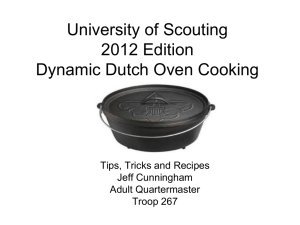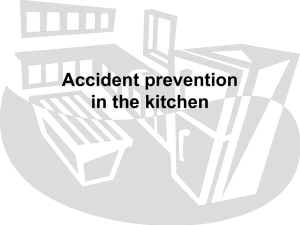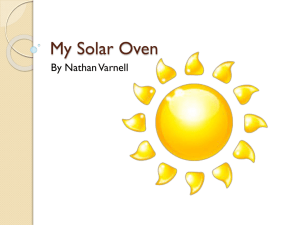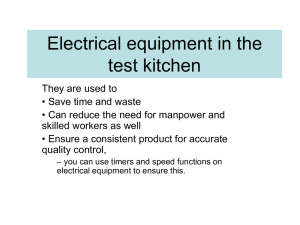Cases – Chapter 7 1. Baking a potato takes a long time, even in a
advertisement
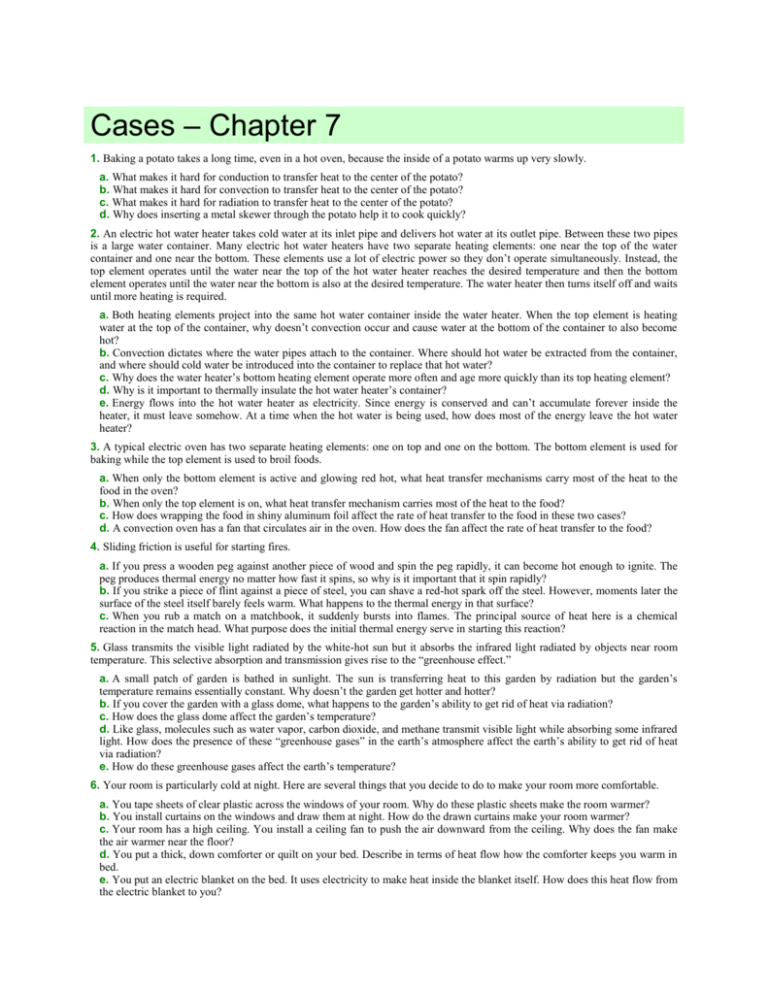
Cases – Chapter 7 1. Baking a potato takes a long time, even in a hot oven, because the inside of a potato warms up very slowly. a. What makes it hard for conduction to transfer heat to the center of the potato? b. What makes it hard for convection to transfer heat to the center of the potato? c. What makes it hard for radiation to transfer heat to the center of the potato? d. Why does inserting a metal skewer through the potato help it to cook quickly? 2. An electric hot water heater takes cold water at its inlet pipe and delivers hot water at its outlet pipe. Between these two pipes is a large water container. Many electric hot water heaters have two separate heating elements: one near the top of the water container and one near the bottom. These elements use a lot of electric power so they don’t operate simultaneously. Instead, the top element operates until the water near the top of the hot water heater reaches the desired temperature and then the bottom element operates until the water near the bottom is also at the desired temperature. The water heater then turns itself off and waits until more heating is required. a. Both heating elements project into the same hot water container inside the water heater. When the top element is heating water at the top of the container, why doesn’t convection occur and cause water at the bottom of the container to also become hot? b. Convection dictates where the water pipes attach to the container. Where should hot water be extracted from the container, and where should cold water be introduced into the container to replace that hot water? c. Why does the water heater’s bottom heating element operate more often and age more quickly than its top heating element? d. Why is it important to thermally insulate the hot water heater’s container? e. Energy flows into the hot water heater as electricity. Since energy is conserved and can’t accumulate forever inside the heater, it must leave somehow. At a time when the hot water is being used, how does most of the energy leave the hot water heater? 3. A typical electric oven has two separate heating elements: one on top and one on the bottom. The bottom element is used for baking while the top element is used to broil foods. a. When only the bottom element is active and glowing red hot, what heat transfer mechanisms carry most of the heat to the food in the oven? b. When only the top element is on, what heat transfer mechanism carries most of the heat to the food? c. How does wrapping the food in shiny aluminum foil affect the rate of heat transfer to the food in these two cases? d. A convection oven has a fan that circulates air in the oven. How does the fan affect the rate of heat transfer to the food? 4. Sliding friction is useful for starting fires. a. If you press a wooden peg against another piece of wood and spin the peg rapidly, it can become hot enough to ignite. The peg produces thermal energy no matter how fast it spins, so why is it important that it spin rapidly? b. If you strike a piece of flint against a piece of steel, you can shave a red-hot spark off the steel. However, moments later the surface of the steel itself barely feels warm. What happens to the thermal energy in that surface? c. When you rub a match on a matchbook, it suddenly bursts into flames. The principal source of heat here is a chemical reaction in the match head. What purpose does the initial thermal energy serve in starting this reaction? 5. Glass transmits the visible light radiated by the white-hot sun but it absorbs the infrared light radiated by objects near room temperature. This selective absorption and transmission gives rise to the “greenhouse effect.” a. A small patch of garden is bathed in sunlight. The sun is transferring heat to this garden by radiation but the garden’s temperature remains essentially constant. Why doesn’t the garden get hotter and hotter? b. If you cover the garden with a glass dome, what happens to the garden’s ability to get rid of heat via radiation? c. How does the glass dome affect the garden’s temperature? d. Like glass, molecules such as water vapor, carbon dioxide, and methane transmit visible light while absorbing some infrared light. How does the presence of these “greenhouse gases” in the earth’s atmosphere affect the earth’s ability to get rid of heat via radiation? e. How do these greenhouse gases affect the earth’s temperature? 6. Your room is particularly cold at night. Here are several things that you decide to do to make your room more comfortable. a. You tape sheets of clear plastic across the windows of your room. Why do these plastic sheets make the room warmer? b. You install curtains on the windows and draw them at night. How do the drawn curtains make your room warmer? c. Your room has a high ceiling. You install a ceiling fan to push the air downward from the ceiling. Why does the fan make the air warmer near the floor? d. You put a thick, down comforter or quilt on your bed. Describe in terms of heat flow how the comforter keeps you warm in bed. e. You put an electric blanket on the bed. It uses electricity to make heat inside the blanket itself. How does this heat flow from the electric blanket to you? 7. A child’s toy oven uses an incandescent light bulb to bake cookies or cakes. It resembles a conventional oven, except that the heating element is simply a 60 W electric light bulb. a. The light bulb is completely enclosed inside the oven and is barely visible from the outside. Nonetheless energy enters the empty oven in one form and leaves in another. What are these two forms? b. How much energy flows into the oven each second? c. After the oven has been operating for a very long time, how much energy leaves it each second? d. Inside the oven, the light bulb is located just below the food. What heat transfer mechanism carries most of the heat from the bulb to the food? e. If the bulb were above the food rather than below it, what heat transfer mechanism would carry most of the heat from the bulb to the food? f. The oven’s door locks when the oven is hot. The lock uses a horizontal bimetallic strip. The lower piece of metal in the strip expands more when heated than the upper piece of metal. Which way does the strip curl when the oven is hot? 8. A duck has a thick layer of fat just beneath its skin. In addition to making the duck more buoyant, this fat helps it stay warm in cold water. a. Why does the duck have trouble maintaining its body temperature in cold weather? b. Why does the duck have more trouble staying warm in cold water than in cold air? c. How does the layer of fat help the duck keep warm? d. Fat is relatively rigid but is chemically almost indistinguishable from liquid oil. Why wouldn’t liquid oil be as effective as semi-rigid fat at keeping the duck warm? e. Muscle tissue is also relatively rigid, but having an extra layer of muscle wouldn’t be as effective at keeping the duck warm as the layer of fat. Why not? f. The duck’s oily feathers also tend to trap air near its skin so that cold water doesn’t actually touch the duck’s skin. Why does this trapped air help keep the duck warm? 9. Changes in temperature can be quite useful in assembling or disassembling metal objects. a. You can remove a tight-fitting iron ring from around a copper cylinder by carefully heating only the iron ring. Why does this technique work? b. Even if you can’t heat the iron ring without heating the copper cylinder, you can free the ring from the cylinder by putting them both in liquid nitrogen, which has a temperature of –195° C. Why should this technique work? c. One scheme for making it impossible to remove an aluminum post from a hole in an aluminum plate involves temperature. If you start with a post that is slightly too wide to fit into the aluminum plate and then chill the post in liquid nitrogen, it will shrink enough to fit. When it warms up it will fit so tightly in the hole that nothing can remove it. Why won’t heating or cooling the post and plate make it possible to extract the post?



